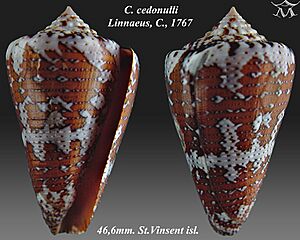Conus cedonulli facts for kids
Quick facts for kids Conus cedonulli |
|
|---|---|
 |
|
| Apertural and abapertural views of shell of Conus cedonulli Linnaeus, C., 1767 | |
| Conservation status | |
| Scientific classification | |
| Synonyms | |
|
Conus cedonulli is a type of sea snail that lives in the ocean. It's a marine gastropod, which means it's a snail that lives in water and has a single shell. This snail belongs to the family called Conidae, also known as cone snails.
Like all cone snails, Conus cedonulli is a predatory animal. This means it hunts other creatures for food. These snails are also venomous. They can "sting" humans, so it's very important to be careful. If you ever see one, it's best not to touch it.
Over the years, scientists have sometimes been confused about how to name and group these snails. This is because Conus cedonulli can look very different. Many similar snails were given different names before scientists agreed on the best way to classify them.
What Does the Conus cedonulli Look Like?
The shell of Conus cedonulli can be white to purplish-grey. Some snails from a place called St. Vincent are often dark brown. A few rare ones can even be almost black.
The shell has streaks that are light and dark. You might also see yellow, brown, or dark dots between these streaks. The snail has a small lid-like part called an operculum. This operculum is much smaller than the shell's opening.
The soft body of the snail itself is dark red. Adult shells usually measure between 38 mm and 78 mm long.
Where Does the Conus cedonulli Live?
The main place where this snail was first found is St. Vincent. This island is part of the Lesser Antilles.
You can find Conus cedonulli in the Caribbean Sea. They live from Colombia to Trinidad. They are also found around the Lesser Antilles and the Bahamas.
Scientists have found these snails off the west coast of Barbados. They were found at depths of about 150 meters. This is likely the deepest they live. In most other places, they are found in much shallower water.
Shell Colors and Forms
Here are some pictures showing the different colors and patterns of the Conus cedonulli shell.





